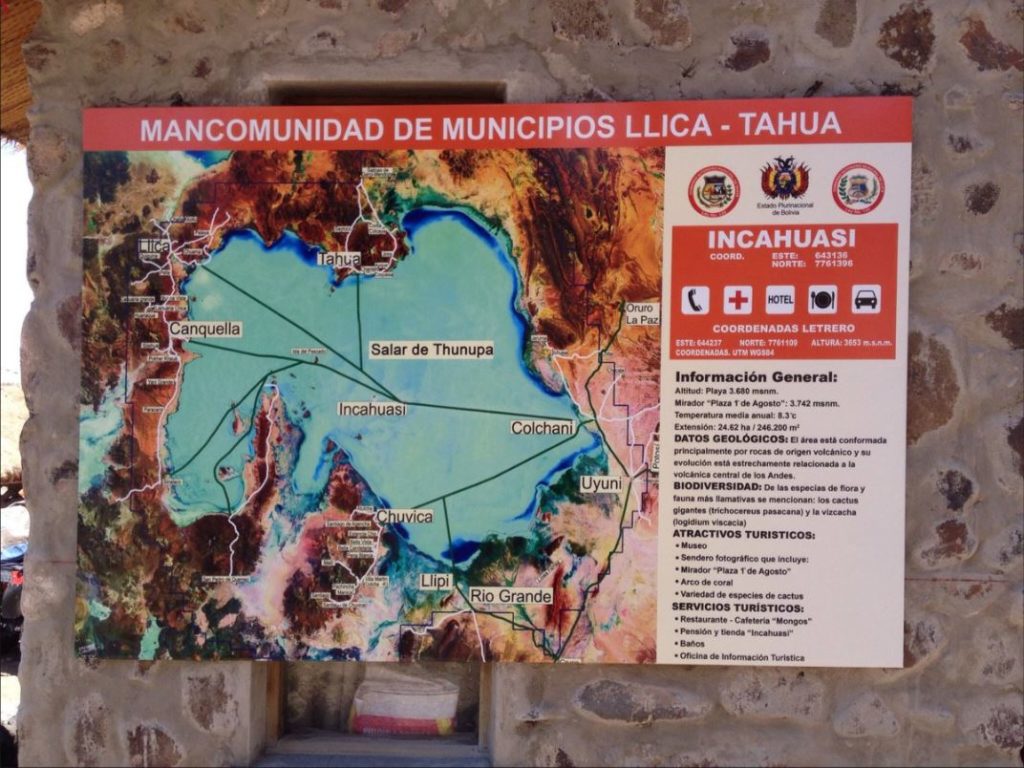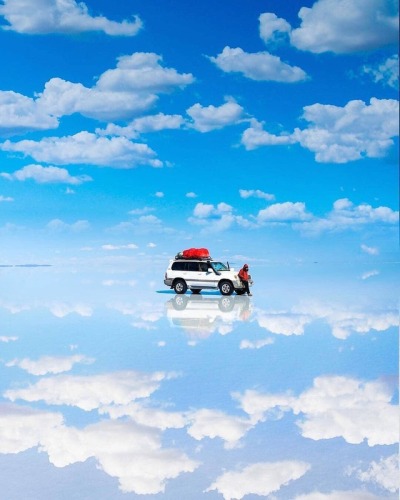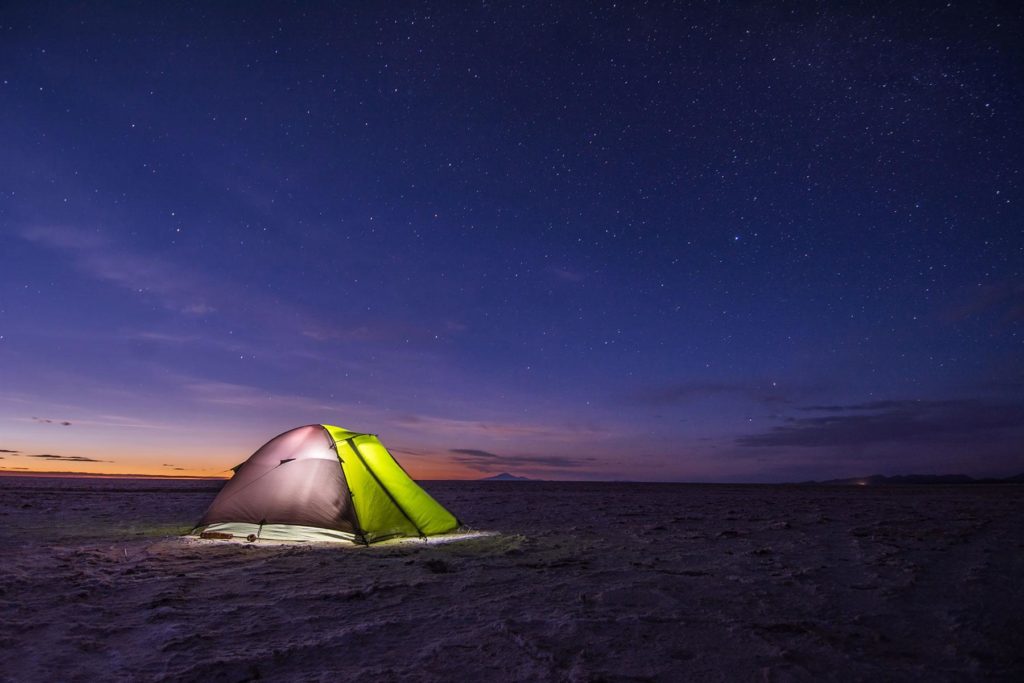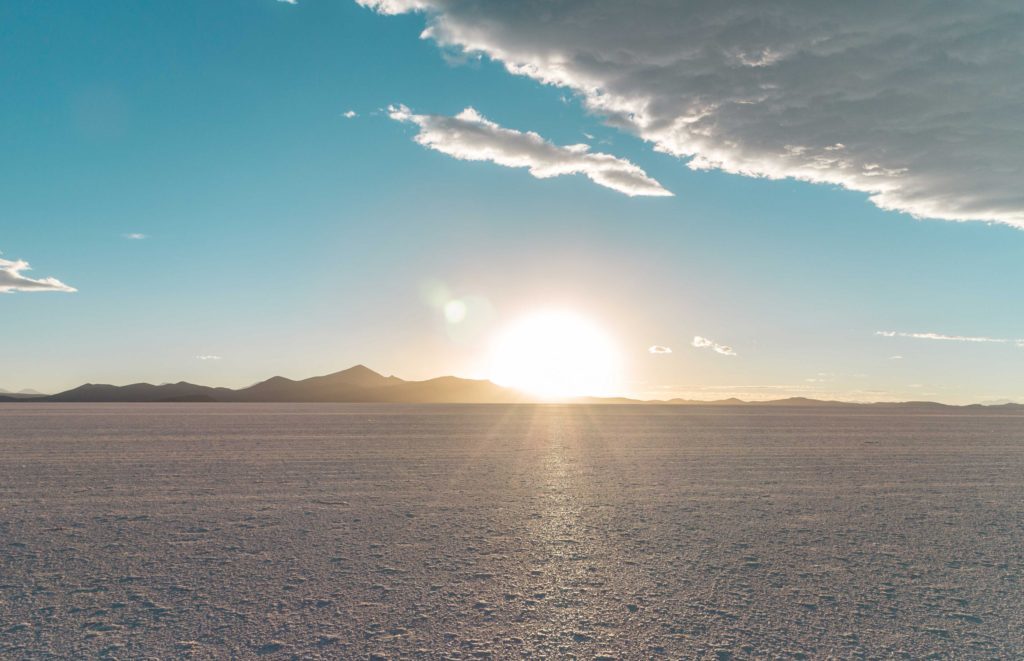Situated just below the Andes in the south west corner of Bolivia, is the Salar de Uyuni salt flats. It is the largest salt deposit in the world, that covers 10,582 square kilometers. With all this space, my buddy and I thought it would be the perfect place to camp for the night.
Most tour operators only do full day tours, and the only other transportation option that we could find were expensive airstream cabins. To have the freedom and privacy to fully enjoy the experience, we felt we needed to sort out our own transportation. We ended up making the decision to rent a 4×4 for a couple of weeks in Uyuni. Whilst camping on the salt flats, we decided to use this company and they treated us really well, so definitely check them out. However please bear in mind that not all rental companies will let you drive on the salt flats, so be sure to ask about this first.
Items to take for camping on the salt flats:
- Warm clothes (temperatures at night plummeted to -10 while we were there)
- Lots of water
- Good quality camping equipment. We brought our tent from home as I read it was going to be hard to find a good one in Bolivia,
- Fold out chairs and also a lilo to sleep on in the tent.
- Sun lotion (make sure you are covered from head to toe as it gets very bright!)
- A decent camera
- A frisbee was a nice bonus!
Best time to go
Dry season (April to November) provides the safest option as the route is clearly designated and there will no grip issues with the vehicle.
Camping on the salt flats could prove tricky in the months of December to March as its the wet season. Though water on the flats cause an amazing shimmering effect. Especially at sunset. However, too much rainfall creates large pools of water which can play havoc with your vehicle.

The salt flat stretch (130 kilometers across)
Entering the flats:
Even though it’s free to enter the salt flats, you can’t just enter the flats at any time, due to the fragility of the salt. We drove to Uyuni and entered the flats at Colchani through the designated path. Before entering the flats, ensure that you protect the vehicle from the salt and get it washed well after leaving. Depending on when you go, there are the occasional bubbling pools which you may pass. This is caused by underground rivers where oxygen is released up to the surface.

Example of the vans you can rent
First stop – Isla Incahuasi (nothing to do with Incas)
Travelling to the rocky outcrop called Islahuasi (which covers sixty acres and is about 45 kilometers from Colchani) felt like it took an age. This is due to depth perception being non existent on the salt flats. Even though you can see your destination, it doesn’t seem to be getting any closer. The first thing you notice is that it is covered in cacti, the oldest and biggest ones being over 900 years old. There are walks you can do which allow you to wind in and out of the cacti. Occasionally spotting one of the alpacas which graze the undergrowth. Another cool thing to see is the coral fossils; the area used to be an ancient sea (hence the salt) roughly 30,000 years ago. If you did want to see the sunset here, I imagine this is a great location for it.
PLEASE NOTE: in the wet season this island can be inaccessible.
Camping for the night – Isla del Pescado
We hopped back in the 4×4 and drove for 25 kilometers until we arrived at the Isla del Pescado. The island’s name comes from its resemblance to a fish from a distance. We heard this would be a good place to set up camp for the night and it certainly didn’t disappoint. It provided shelter from the wind, yet was quieter than Isla Incahuasi. This solitude let us appreciate the immensity of the salt from every vantage point. During the night, the stars were so bright but due strong winds outside and the temperature dropping below freezing. We had to wrap up if we wanted to stay outside and stargaze!

The peacefulness of camping on the flats – Photo Fodors
Seeing the sunset
We walked up to the top of the island and, despite the weather, it did have a sereneness that I have never experienced before. This is where having a small amount of groundwater allowed for a mirror effect in which the sun’s rays shimmered for miles. Being next to an outcrop also provided a long shadow which extended far over the flats. Looking out at the Isla del Pescado as the sun hit the rocks, marvellous colours illuminated every nook and cranny.

Sunset on the flats is breathtaking
Leaving
The next day, after enjoying a hearty breakfast, we left via San Pedro de Quemez, which was roughly another 30 kilometers off the salt flats. This is the best way to check out Tupiza or the colored lakes, as they are south (sort of) of the salt flats.
Other options
If you did want to stay in a hotel, there is one made completely out of salt called the Casa del Sol which is located at the salt flats back in Uyuni. This is normally included when you book a tour. Most of the action is in Uyuni, with tour prices ranging from $100-200 for a 3 day tour, normally with lodging included.
I have also heard of people travelling to the center of the salt flats by bicycle and motorbike and setting up tents for the night. You definitely have plenty of options but make sure to bring enough kit with you.


Emmitt Galicinao says:
Geez! I heard some crazy news about the Bolivian president! I guess Evo Morales stepped down from his position. Accusations of election fraud are causing mass protests. It seems like the world’s gone mad…